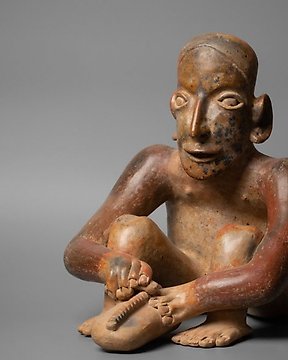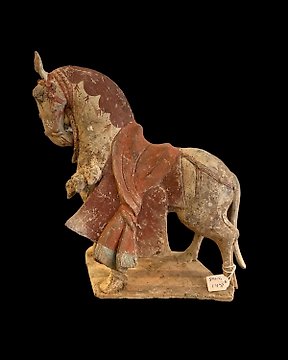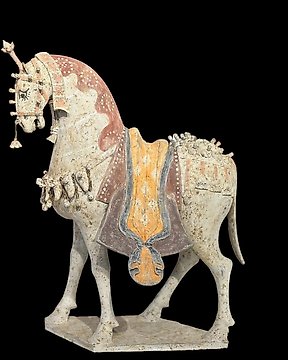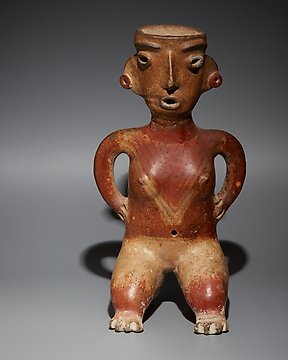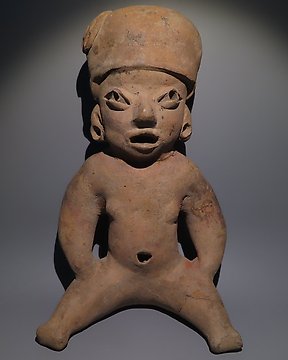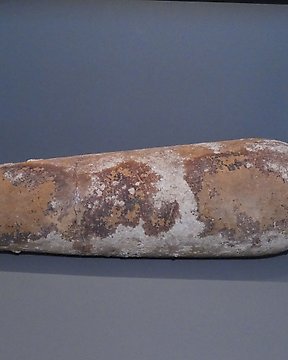Todo perfecto, recomendable.
Se översättningColima, västra Mexiko Terrakotta Fin perfekt hundfigur. 34 cm L. 100 f.Kr. - 250 e.Kr. Spansk exportlicens.
Nr 85335479

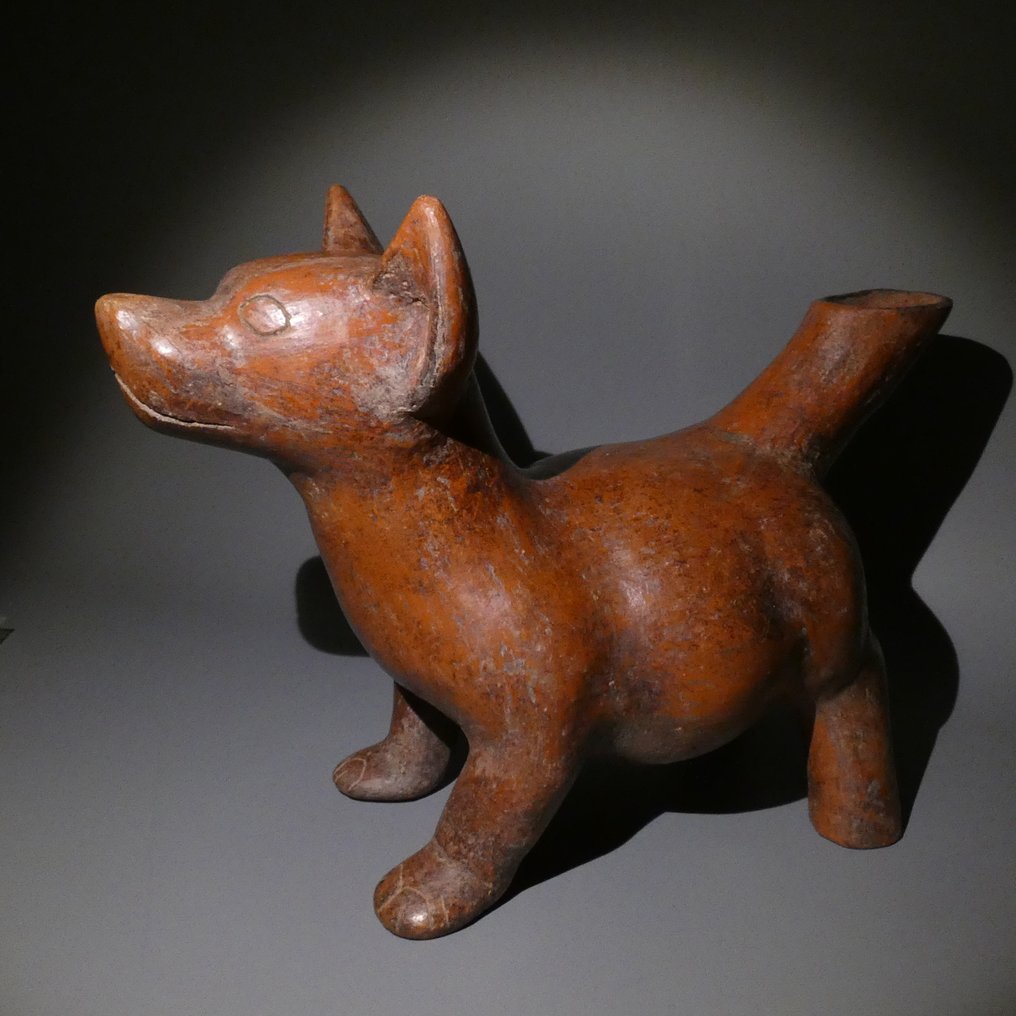

Dog figure
- fine quality -
Colima, West Mexico, 100 BC - 250 AD
Terracotta.
DIMENSIONS: 34 cm long and 24 cm heigth.
PROVENANCE: Private collection B. L. , Paris. Acquired in the 1980s. Ex. Art Tribal II Sale, Rossini, France, 21 January 2002, lot 34. Spanish export license.
CONDITION: Very good quality, see photos.
A realistic depiction of a dog encompassed within the pieces known as “Colima dogs”, due to their origin in the Colima culture. It is made from orange-brown burnished clay in which can be seen root marks in a deeper tone. The animal is seen in a curious pose, given that the most common one for these figures shows the dog in an alert static position. It is seated with its rear on the ground and its two front legs holding up the rest of the body. At the same time the animal has raised one back leg towards the head. This movements suggests that it is trying to scratch the head or an ear Although the pose is visually attractive, and the tail also gives a sense of balance to the representation, it is clear that the pose is in fact an impossible one. The head is held upright looking towards the horizon. The details have been rendered by the use of fine incisions. The work on the half-open mouth, showing canine and other teeth, is of particular note. The dog has been purposely depicted in a realist manner.
This type of dog is of the Tlalchichis breed, a hairless dog particularly valued - especially among the social elite - not only for its company, but also to be eaten for its meat. As they dogs were fattened up for consumption, statuettes of these dogs were placed in tombs as a symbolic footstuff in the Afterlife.
For a long time it was believed that the dog represented in most of the pottery which came from Mesoamerica was the Xoloitzcuintle, as it is a very famous breed of Mexican dog. But it has been concluded that these dog pieces are Tlalchichis rather than Xoloitzcuintles. The differences are not only physical, but also imply a vision of the cosmos of the indigenous inhabitants. The Xoloitzcuintles have long straight legs, and are tall and thin; the Tlalchichis were small, fat, hairless animals with bowed legs.
It is believed that the Tlalchichis were used as a substitute for humans in sacrifices, given the evidence found in the tombs known as “shaft” tombs, where the body of a dog was found with a severed head. Other figures as well had the body of a dog but with a human head or perhaps a mask with a human appearance, which could support the theory of the substitution of one for the other.
The idea has also been refuted that the oldest dog, the one thought to have wrinkled skin, was the one which passed on its knowledge to the smallest one. On the contrary, zoological studies show that this breed of dog only had this type of wrinkled skin when the dogs were puppies. There are many representations which show them with fat bellies, wide smiles and even dancing, one embracing another.
Moreover, it was believed that they were the representation of the later Aztec god, Xólotl, who, as is common in most of the world’s cultures, guided the souls of the deceased into the Other World. The northwest of Mexico, where the Colima culture developed, is characterized by a low-lying coast carved by valleys. Each one has its own ecology with a warm, humid climate.
Little is known about their modes of subsistence, as most of the information we have comes from the funerary material, not inhabited sites which usually provide this kind of information. Thanks to their practice of irrigation farming, it was possible for them to support a relatively large population. They lived in small villages and relatively independent urban centres.
Colima ceramics display a wide variety of figures and shapes, but little variation in technique. Most pieces have a burnished red finish and some are decorated with orange or white incisions. Moulded figures are common, especially of plants, animals (above all dogs) and seashells. Human representations typically feature dwarfs and hunchbacks more than others, and few female forms. Many of these figures have “coffee-bean” eyes and are dressed in finely detailed traditional attire. Little is known of Colima stonework; only a few pieces such as mace heads, small masks and figurines have been found. These people also practiced basket-weaving and weaving, and used metallurgy to make objects such as needles, axes, rattles, nose rings and ear ornaments.
The vast majority of ceramic pieces that have been ascribed to this culture are grave offerings found in the tombs of individuals of high social rank. The Colima buried their dead in complex hypogea, called “shaft” tombs, made up of a shaft which, in some cases, was up to 30 meters deep, at the bottom of which there were one or more chambers where members of the same family were buried. The bodies were accompanied by a wide variety of objects, and offerings in the form of ceramic representations. Among these ceramic statuettes of armed men stand out, whose task it would have been to serve as symbolic guardians of the tomb.
BIBLIOGRAPHY:
- Sculpture of Ancient West Mexico. Los Angeles County Museum of Art. 1970.
- Trésors de la céramique précolombienne dans les collections Barbier-Mueller. 2003.
- VON WINNING, Hasso. Pre-Columbian Art of Mexico and Central America.
- TOWNSEND, Richard F. Ancient West Mexico. Art and Archaeology of the Unknown Past. Thames & Hudson. Chicago. 1998.
The seller guarantees that he acquired this piece according to all national and international laws related to the ownership of cultural property. Provenance statement seen by Catawiki. The piece includes authenticity certificate. The seller will take care that any necessary permits will be arranged.
Dog figure
- fine quality -
Colima, West Mexico, 100 BC - 250 AD
Terracotta.
DIMENSIONS: 34 cm long and 24 cm heigth.
PROVENANCE: Private collection B. L. , Paris. Acquired in the 1980s. Ex. Art Tribal II Sale, Rossini, France, 21 January 2002, lot 34. Spanish export license.
CONDITION: Very good quality, see photos.
A realistic depiction of a dog encompassed within the pieces known as “Colima dogs”, due to their origin in the Colima culture. It is made from orange-brown burnished clay in which can be seen root marks in a deeper tone. The animal is seen in a curious pose, given that the most common one for these figures shows the dog in an alert static position. It is seated with its rear on the ground and its two front legs holding up the rest of the body. At the same time the animal has raised one back leg towards the head. This movements suggests that it is trying to scratch the head or an ear Although the pose is visually attractive, and the tail also gives a sense of balance to the representation, it is clear that the pose is in fact an impossible one. The head is held upright looking towards the horizon. The details have been rendered by the use of fine incisions. The work on the half-open mouth, showing canine and other teeth, is of particular note. The dog has been purposely depicted in a realist manner.
This type of dog is of the Tlalchichis breed, a hairless dog particularly valued - especially among the social elite - not only for its company, but also to be eaten for its meat. As they dogs were fattened up for consumption, statuettes of these dogs were placed in tombs as a symbolic footstuff in the Afterlife.
For a long time it was believed that the dog represented in most of the pottery which came from Mesoamerica was the Xoloitzcuintle, as it is a very famous breed of Mexican dog. But it has been concluded that these dog pieces are Tlalchichis rather than Xoloitzcuintles. The differences are not only physical, but also imply a vision of the cosmos of the indigenous inhabitants. The Xoloitzcuintles have long straight legs, and are tall and thin; the Tlalchichis were small, fat, hairless animals with bowed legs.
It is believed that the Tlalchichis were used as a substitute for humans in sacrifices, given the evidence found in the tombs known as “shaft” tombs, where the body of a dog was found with a severed head. Other figures as well had the body of a dog but with a human head or perhaps a mask with a human appearance, which could support the theory of the substitution of one for the other.
The idea has also been refuted that the oldest dog, the one thought to have wrinkled skin, was the one which passed on its knowledge to the smallest one. On the contrary, zoological studies show that this breed of dog only had this type of wrinkled skin when the dogs were puppies. There are many representations which show them with fat bellies, wide smiles and even dancing, one embracing another.
Moreover, it was believed that they were the representation of the later Aztec god, Xólotl, who, as is common in most of the world’s cultures, guided the souls of the deceased into the Other World. The northwest of Mexico, where the Colima culture developed, is characterized by a low-lying coast carved by valleys. Each one has its own ecology with a warm, humid climate.
Little is known about their modes of subsistence, as most of the information we have comes from the funerary material, not inhabited sites which usually provide this kind of information. Thanks to their practice of irrigation farming, it was possible for them to support a relatively large population. They lived in small villages and relatively independent urban centres.
Colima ceramics display a wide variety of figures and shapes, but little variation in technique. Most pieces have a burnished red finish and some are decorated with orange or white incisions. Moulded figures are common, especially of plants, animals (above all dogs) and seashells. Human representations typically feature dwarfs and hunchbacks more than others, and few female forms. Many of these figures have “coffee-bean” eyes and are dressed in finely detailed traditional attire. Little is known of Colima stonework; only a few pieces such as mace heads, small masks and figurines have been found. These people also practiced basket-weaving and weaving, and used metallurgy to make objects such as needles, axes, rattles, nose rings and ear ornaments.
The vast majority of ceramic pieces that have been ascribed to this culture are grave offerings found in the tombs of individuals of high social rank. The Colima buried their dead in complex hypogea, called “shaft” tombs, made up of a shaft which, in some cases, was up to 30 meters deep, at the bottom of which there were one or more chambers where members of the same family were buried. The bodies were accompanied by a wide variety of objects, and offerings in the form of ceramic representations. Among these ceramic statuettes of armed men stand out, whose task it would have been to serve as symbolic guardians of the tomb.
BIBLIOGRAPHY:
- Sculpture of Ancient West Mexico. Los Angeles County Museum of Art. 1970.
- Trésors de la céramique précolombienne dans les collections Barbier-Mueller. 2003.
- VON WINNING, Hasso. Pre-Columbian Art of Mexico and Central America.
- TOWNSEND, Richard F. Ancient West Mexico. Art and Archaeology of the Unknown Past. Thames & Hudson. Chicago. 1998.
The seller guarantees that he acquired this piece according to all national and international laws related to the ownership of cultural property. Provenance statement seen by Catawiki. The piece includes authenticity certificate. The seller will take care that any necessary permits will be arranged.
- 112
- 6
- 0
Really precious, as usual :-)
Se översättningmolto bello ok
Se översättningParfait ! superbe objet, vendeur top compétence et très symapthique.
Se översättningthanks
Parfait, très bonne communication. Muchas gracias.
Se översättningBestens, danke!
Se översättningtodo bien 👍
Se översättningLlego muy bien y es muy bonita. Gracias
Se översättningVendeur très professionnel & réactif. Colis parfaitement protégé. Merci encore
Se översättningtodo bien 👍
Se översättningOggetto valido anche se il venditore doveva inviare un supporto per esporre : tanto più che trattasi di venditore professionale. La certificazione inviata è ambigua sulle dichiarazioni rillasciate
Se översättningTodas sus piezas han sido cuidadosamente seleccionadas , en garantía del comprador.
Se översättningMuy linda, dura y con buen peso. Envío super rápido.
Se översättningtodo bien 👍
Se översättningas described, all godd, thank you!
Se översättningVery nice as discribed
Se översättningVakkundige verpakking tijdens transport.Zou echter een officiële bevestiging willen van de echtheid
Se översättningExceptionnel !!! Envoi rapide et soigné. Un dernier mot : MAGNIFIQUE !!!
Se översättningTodo correcto.
Se översättningOggetto molto bello e come da descrizione. Nel pacco erano allegati anche ricevuta d'acquisto e dichiarazione di autenticità del venditore. Tutto bene!
Se översättningI'm very happy !!! Beautiful. Rapide et efficace!! LLAP
Se översättningVlotte verzending met DHL. Professionele verpakking en certificaat. Met dank.
Se översättningItem arrived quickly and carefully packaged, I am very pleased with it!
Se översättningSehr rasche Transaktion und schönes Stück!!
Se översättningEl pequeño busto es hermoso. Bien empaquetado. Entrega rápida. Estoy satisfecho 👍👍👍
Se översättningAnsvarsfriskrivning
Säljaren garanterar och kan bevisa att objektet införskaffats på lagligt sätt. Säljaren har informerats av Catawiki att de måste lämna den dokumentation som är obligatorisk enligt lagar och regler i det land de är bosatta. Säljaren garanterar och har rätt att sälja/exportera detta objekt. Säljaren tillhandahåller all information om härkomst som är känd om objektet till köparen. Säljaren säkerställer att alla nödvändiga tillstånd är/kommer att bli ordnade. Säljaren informerar köparen omedelbart om eventuella förseningar gällande att anskaffa sådana tillstånd.
Säljaren garanterar och kan bevisa att objektet införskaffats på lagligt sätt. Säljaren har informerats av Catawiki att de måste lämna den dokumentation som är obligatorisk enligt lagar och regler i det land de är bosatta. Säljaren garanterar och har rätt att sälja/exportera detta objekt. Säljaren tillhandahåller all information om härkomst som är känd om objektet till köparen. Säljaren säkerställer att alla nödvändiga tillstånd är/kommer att bli ordnade. Säljaren informerar köparen omedelbart om eventuella förseningar gällande att anskaffa sådana tillstånd.
